ADM. LORIN SELBY: Hi, how’s everybody doing? It’s after lunch, a little after noon, head nods are setting in for some of you. Who’s a Houston Astros fan here, anybody? Alright, I’m with you. It’s not my team but I want to see them win. After that hurricane I think the town deserves a big win.

I am going to talk to you today about what I do at NAVSEA and how we support the undersea vision that Admiral Tofalo and Admiral Caldwell laid out earlier. I’ve got a few slides to walk you through some of the things we do at NAVSEA in general, and what I specifically do as SEA 05 or the chief engineer for NAVSEA.
I’m pretty much the chief engineer for the Navy, just about every ship, submarine, aircraft carrier and all the associated combat and weapons systems on those ships and submarines throughout the fleet fall under my cognizance. It’s a lot of stuff and it keeps me pretty busy.
Let’s talk about NAVSEA. Most of you know who we are. Think about the history. For 220 plus years NAVSEA has been in existence. We’ve had several names throughout that time, and you can see that on the slide: Board of Naval Commissioners, Bureau of Ships, Bureau of Ordnance, and now NAVSEA. But the function really has always been to deliver those ships, those submarines, those aircraft carriers and maintain them when they get to the fleet. That’s what we do.
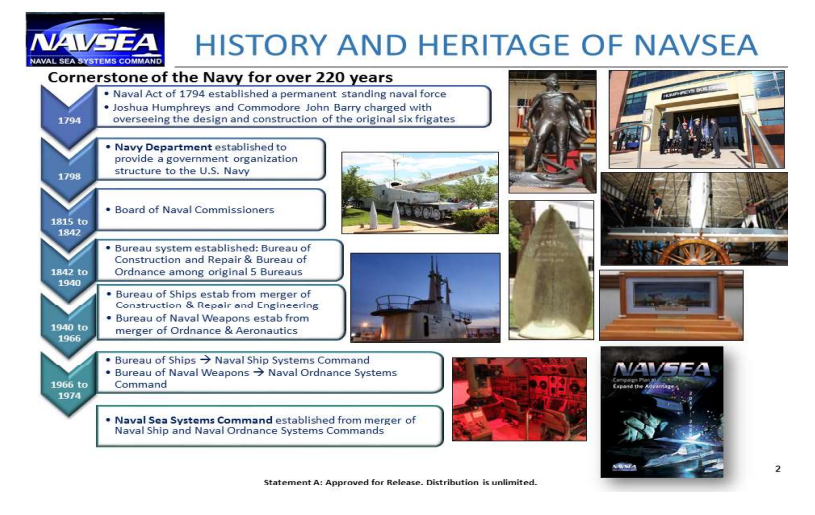
If you look over the history ofNAVSEA, think about the transitions that have happened in the Navy during that time period. We went from the days of sail to the days of steam, coal fired steam to oil fired steam to nuclear powered steam. We went from the days of shooting cannonballs to shooting projectiles in rifled barrels that you could shoot 25-plus miles down range with accuracy especially when you brought in the radars that we integrated with the fire control system.
Think about the transition we made when it comes to the weapons systems when we made the leap to missiles. Think of the Tartar, Terrier, and Talos missile days when we were shooting missiles hundreds of miles. We were intercepting contacts in the air using Aegis Combat System integrated with the missile system to tie the fire control system to that weapon as it intercepts and takes out that threat. That’s a pretty amazing capability.
That’s a lot of innovation and advances throughout that time period, and we are still doing that today. Think of the rail gun. Think of lasers. Those are technologies that we’re still working on. We’re trying to go to the cutting edge with these technologies and bring them to the force not 20 years from now, but today.
Think of the laser on Ponce that has been deployed to the Gulf for the last several years very successful operations. Or the rail gun that we continue to test at Dahlgren Virginia. We’ve actually got it on the River Range now shooting it down river. At some point we need to take it out to White Sands, New Mexico to validate it’s capability at range. This is all amazing technology that we’re working with today and I’m going to talk to you a little bit about some of that.
Like any organization, we’ve got a strategic framework. What this basically says is our mission is to deliver ships and submarines to the fleet combat ready, on time and on cost. In fact, we’ve got three key areas of focus. One is on time delivery of ships and submarines. The second one is developing a culture of affordability. We’ve got to do that smart
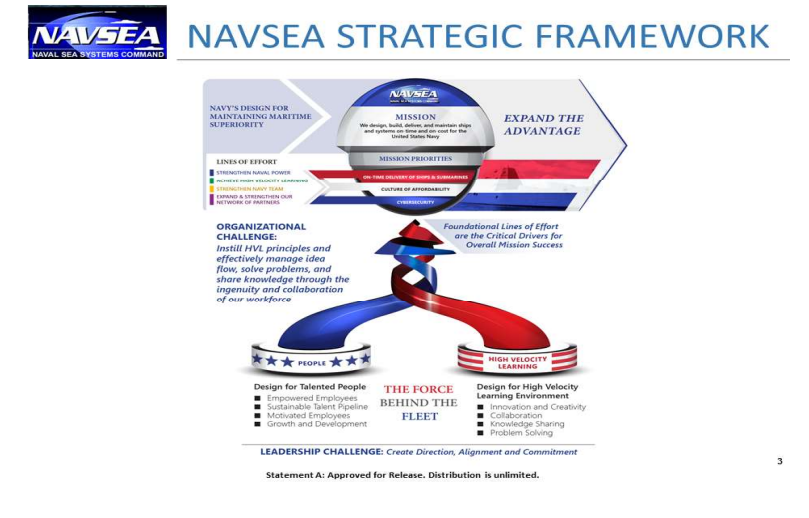
ly being conscious of the taxpayers’ money and finding new innovative ways to do business to try and do it at less cost and to get more bang for the buck. The third focus is cyber security.
I think Admiral Tofalo spoke to that. It’s a huge focus for us. Cyber security is not just your IT network. That’s really SPAWAR’s mission. My mission is focused more on those machinery control systems, the hull mechanical and electrical systems, and then the combat systems on those ships and submarines. Those are the ones we’re going after.
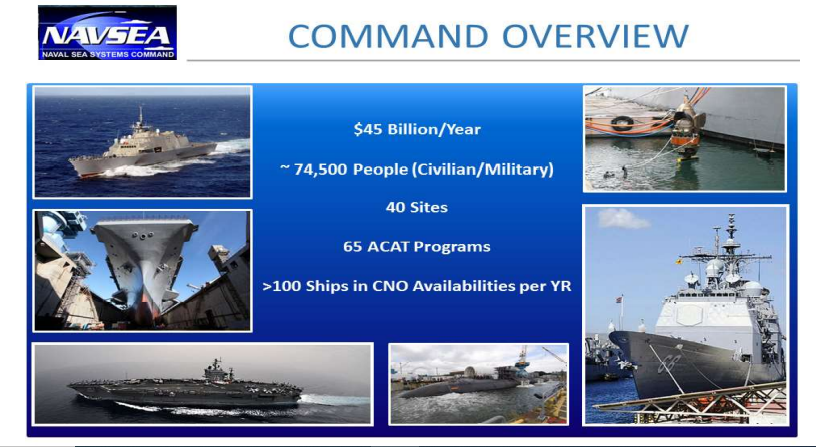
So how do you do this? Well, you do it with a lot of dedicated Americans: roughly 75,000 men and women. Over the course of the year, about $45 billion comes in and out through various accounts to do those missions. Sixty five ACAT programs across five PEO and roughly 100 CNO availabilities during that timeframe, and that’s year after year after year we continue to do that.
Where are we? We’re actually all over the globe. Obviously a heavy presence is across the United States. You know the four Naval Shipyards, we’ve got warfare centers across the country. I command the Surface Warfare Centers, there’s eight centers right there alone. Then there are the regional maintenance centers.
We’ve also got overseas presence in places like Bahrain and Rota, where we do maintenance overseas on forward deployed ships and submarines. When there’s a problem anywhere in the world we can send a team we’ll send a team to the ship, and we do that routinely.
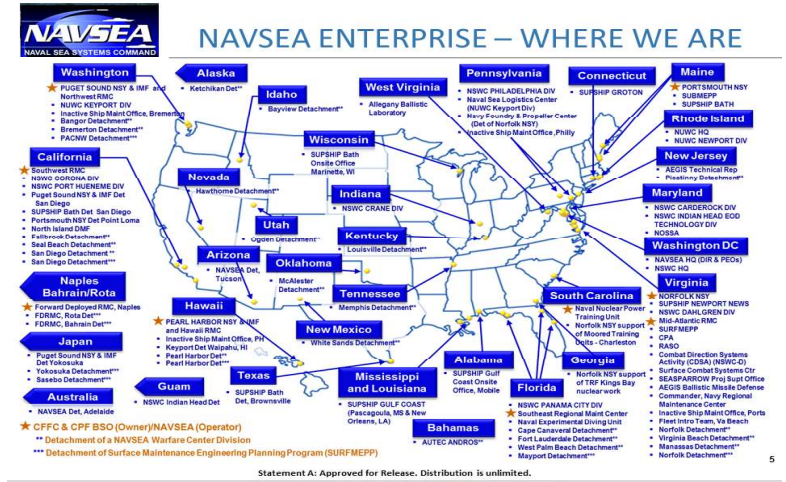
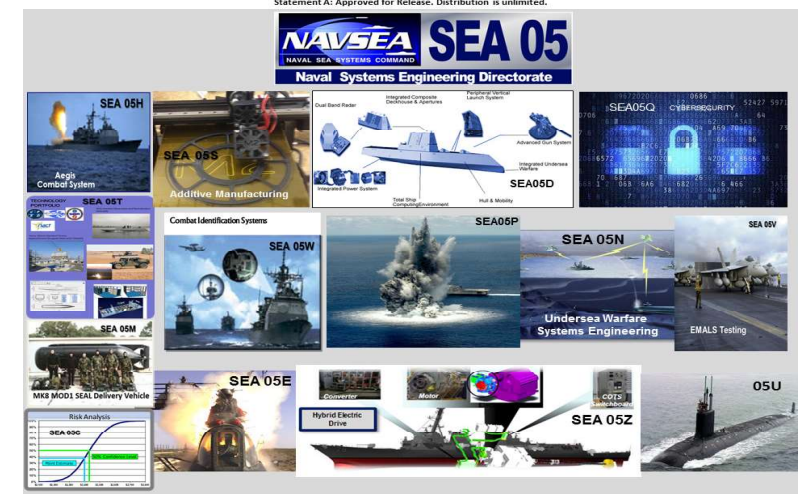
What is SEA 05? Admiral Donnelly spoke to the fact that the chief engineer is the engineering director for the Navy. What does that really mean?
If you look at the pictorial, the top left, 05H is my code that deals with combat systems, so Aegis Combat Systems and Ship Self Defense Systems that are on carriers and our big deck amphibs.
Next there’s 05S, that’s my standards group. Think of publications, NSTMs, tech manuals. And think about a new technology like additive manufacturing. How do we write the book on that? How do we develop the standards to ensure those components are going to be safe to operate on our ships and our submarines? How do we actually get to a point where we can print a sub-safe component? We’re going to get there.
Some of the ships are actually pushing pretty hard in this area. Some of our vendors are doing that as well. We’re looking hard at that and we’re developing the standards. We’re working with OPNAV to develop a funding line to help us develop those standards for additive manufacturing.
Just think about this, we’ve had literally thousands of years of experience when it comes to metals: molten metals, machining metals, forging metals; additive manufacturing not so much. We’re in maybe the second decade of using this new technology. Think of all the stress strain curves we have to generate and the Charpy v-notch testing! We have to do those tests with all types of materials and all types of 3-D printers.
We’ve got to quality all of those materials and all of those different printers, so we’re working through a way to do that right now at NAVSEA 05, teaming with NAVAIR and others. It’s really a non trivial problem!
O5D is my ship design group. This is surface ship design, think of the folks who do all the design work for the next frigate and the next future surface combatant. They’ve got all the naval architects for the Navy, working at SEA 05, or at the Naval Surface Warfare Center Carderock.
On the top right, this is my newest group, 05Q. We stood this up in the summer of 2016. This is my cyber security group. So again, you can see the importance of the mission. This group is looking to protect all machinery control systems for all hull mechanical and electrical systems on Navy ships and submarines, as well as the combat systems. The IT communications systems are handled by SPAWAR. But we have a very close partnership with SPAWAR as we handle the tech authority for these components.
Going to the middle left, we’ve got OST. This is the technology group, so this is the group I spoke about a minute ago that does all of the advanced technologies: lasers, rail guns; I’ll talk about Big Data here at the end, but Big Data, artificial intelligence, and autonomy are new areas we are focusing on. We’ve also got a lot of work here on additive manufacturing. So they’re working with 05S kind of working the standards, but also working the hardware piece of that.
To the right of that you’ve got 05W. These are weapons systems associated with surface platforms. Think of missiles. Think of cooperative engagement systems. Those are 05W.
05P in the middle, that’s a picture of a full ship shock trial. 05P does everything from shock, structures, to waste disposal systems. Think of the plasma arc waste disposal system on the Ford. They handle many of the different systems associated with environmental compliance, as well as fire protection, so fire fighting systems, fire detection systems, that’s 05P. It’s actually a pretty heavy lift. They do a lot of hard work for NAVSEA when it comes to new designs, and many in service issues in the fleet.
05N, the next one on the right, that’s undersea systems, so think of your combat systems on the submarine, weapons systems on the submarine. It’s your undersea warfare systems.
05V, the far right in the middle, that’s my aircraft carrier group. I’ve got a whole group dedicated to aircraft carriers, both the in service aspects of it as well as the new design aspects of it. So we were heavily engaged over the past several years in getting Ford delivered. It’s a lot of hard work, working closely with Naval Reactors, as well as the rest of NAVSEA and the ship builder, to get a ship like Ford to sea for the first time.
I was fortunate enough to be on that ship for its delivery, along with Admiral Caldwell, and it’s an amazing capability. We’ve now actually gotten close to 90 catapult shots with the EMALs system, the Electro Magnetic Aircraft Launch system, as well as aircraft traps with the Advanced Arresting Gear, the AAG. We’ve been doing initially shake down of Ford for the last several months, so a lot of great work, a lot of great progress bringing all of those new systems online.
To the bottom left you’ve got two things there. One is 05M. All those Navy SEALS standing in front of that SEAL delivery vehicle, so they do mine warfare as well as special operating force work. So again, SEAL delivery vehicles, shallow water combat submersibles, SWCS, as well as your traditional mine hunting systems, whether it’s MCMs or the new unmanned systems. That’s all mine hunting.
Below that at the bottom left is 0SC. That’s my cost estimating group. This is a NAVSEA group that does all of the Navy’s first cost estimates come out of05C before they go to the Pentagon and CAPE and others take them. They start at NAVSEA. So we work very closely with program offices, with the shipbuilders, keeping track of all the new cost factors that go into the new construction of a ship or weapons system.
Then there’s 0SE, that’s a picture of an ejection seat, so it’s energetics. We work very closely with Indian Head, which is the Surface Warfare Center in Indian Head, Maryland where we actually develop and manufacture cartridge actuating devices, which actually eject things like ejection seats out of airplanes, and energetics.
The bottom center is 0SZ, this is my Marine Engineering Group. This group does everything from electrical distribution, electrical generation, steam systems, gas turbines, diesel engines, that’s all in 0SZ. They’re also the group that I’ve got working very closely with OST on some of those advanced analytics that I’ll talk about in one of my last slides.
And the bottom right, last but not least, is 0SU, the undersea warfare branch. This room is probably the most familiar with that group. Again, it’s everything from submarine design, submarine operations, in-service work, that’s 0SU.
What’s the alignment with the PEOs? I’m going to talk to this. If you think of those different codes I talked to, each PEO is mapped to a different part of my technical pyramid. PEO ships works heavily with 05D. That’s those ship designers, the same with PEO LCS, the Littoral Combat Ships. They work closely with 05D and 05H for the combat systems: AEGIS or SSDS.
The carrier group marries very closely to 05V as well as 05H, be cause again, carriers have a combat system SSDS. They get other major support from the structures guys in 05P. They do the mine work with the folks in 05M, the warfare systems folks in 05W, and the electrical folks
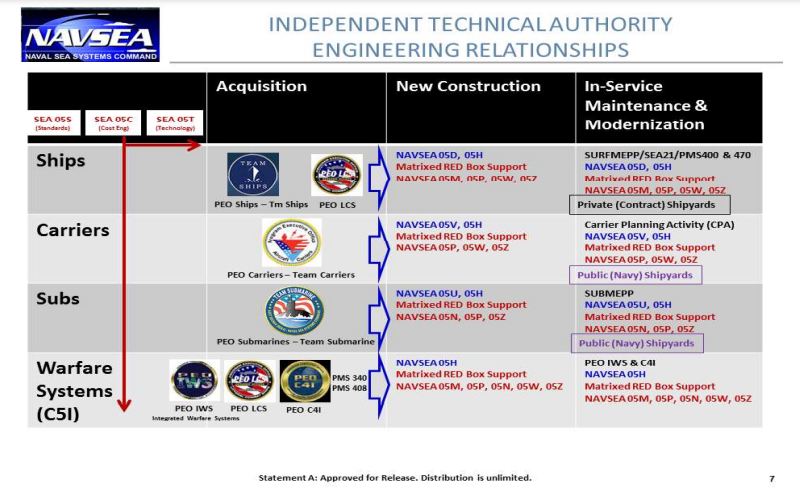
in 05Z.
The next one down is subs, so 05U is heavily linked to them. Sub marine combat systems are aligned to 05N. And at the bottom, we work closely with 05P on structures, propulsor design, and firefighting systems, for example.
I talked a lot about tech authority. One of the things that I have which is granted to me by the secretary of the Navy via my boss Admiral Moore, COMNAVSEA, is tech authority for the systems under my cognizance. So to talk about tech authority, it’s often better to talk about what happens when you don’t have tech authority.
There’s two examples here. The first example is Columbia but Challenger falls in the same category.
NASA has a lot of very bright engineers, and they work with cutting edge technology. But what they did not have was a dedicated branch that had what I’ 11 call independent tech authority. That’s the ability to identify a technical issue or a technical problem and be able to basically throw a red card and say, no, we’re going to stop. We’re not going to proceed. They didn’t have that structure. There were plenty of people at NASA that knew what would happen if you took an O-ring down below 32 degrees and froze it, you were going to get blow-by: That’s what
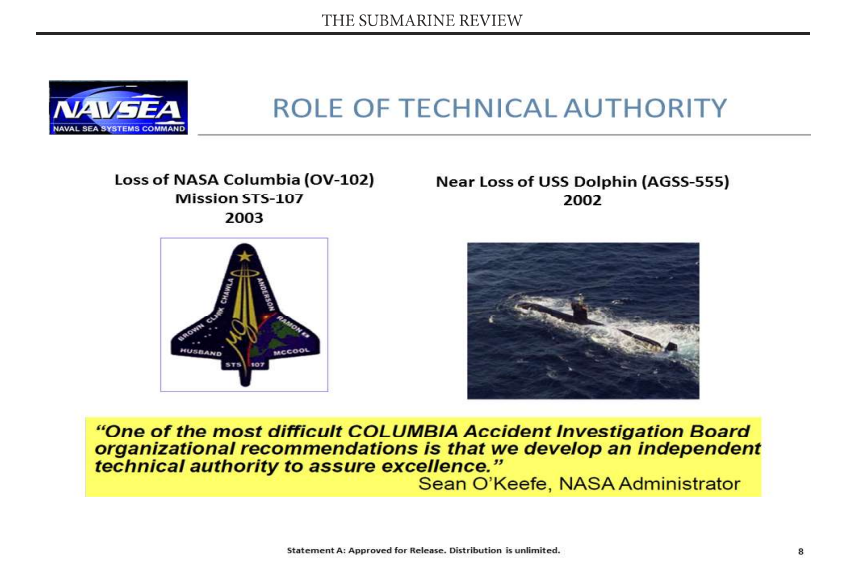
happened to Challenger. On Columbia you had foam from the fuel tank hit the wings of the shuttle on launch. Again there were engineers who knew that damage to the leading edge of the shuttles wings would hap pen and that it was only a matter of time before a critical failure happened. Again, they didn’t have the avenue or the venue to say, no, and stop the launch.
They were faced with pressure the pressure on the other side was the operational pressure to get the shuttle into space, the cost pressure of what it takes to fuel the shuttle and then de fuel it to wait for another launch day. Those pressures over rode the technical. We don’t want to do that.
We had a similar issue on Dolphin. There was a waterfront decision to change an 0-ring on a door gasket. It was not vetted by headquarters. Because of that, they had a flooding event – they flooded out part of the ship. It was nearly catastrophic. It was a near miss.
We don’t want to go there. So we very tightly hold our tech authority really kind of close to the vest at NAVSEA. That gives me the authority to, if I deem something unsafe, or that there is too much risk, I can say no, and I have said no. That’s my job, to be looking at these technical issues with an objective view with an independent view. We get the data, the facts, the objective quality evidence and make the assessment
whether something is safe or not to operate. That’s what we do. That’s what this tech authority is and that’s a really important part of what I do for the Navy.
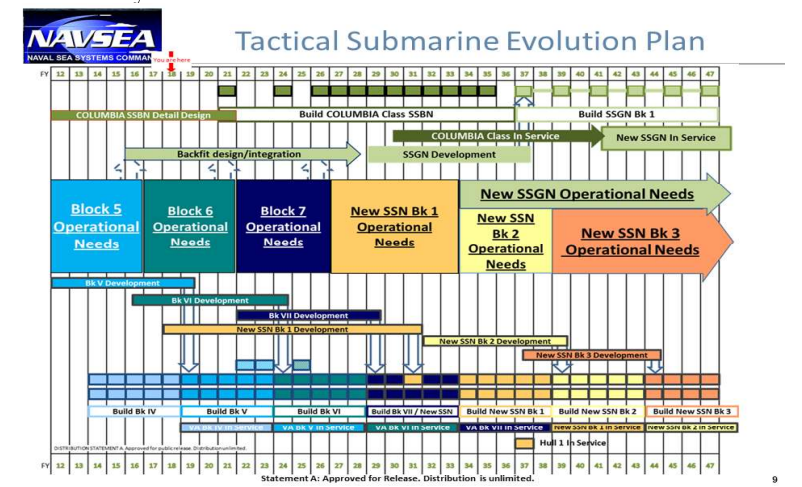
We’re going to transition to some advanced technologies and where we’re going in the future. This is the TSEP, the Tactical Submarine Evolution Plan that some previous speakers spoke to. This lays out kind of what I look at is opportunities for inserting technologies. So if you look at Block V, VI, VII and beyond, these are opportunities for us to actually insert new capabilities and technologies into the submarine force.
The first one coming is Block V. This is going to be really kind of game changing. For me, when I was at N87 back then in 2007 and ’08, I left there to come to NAVSEA for my first NAVSEA tour, this was just an idea – not even a power point yet! From that idea we pushed this thing and we got support across Navy and DOD and on the Hill, and here we are. We started the design work and we are now, as Admiral Caldwell spoke earlier, going to start construction in 2019, delivering it in 2024.
This is going to be a game changing capability. It brings us four additional tubes, seven missiles per tube. And it’s not just adding a hull section with missiles. We had to bring in an integrated ballast tank as well as another equipment space. So this is very carefully crafted for weight and stability, and we honed in on about an 87-foot length as the right length to do this. So as we said earlier, this is actually underway now and getting ready for a 2019 start. I’m pretty excited.
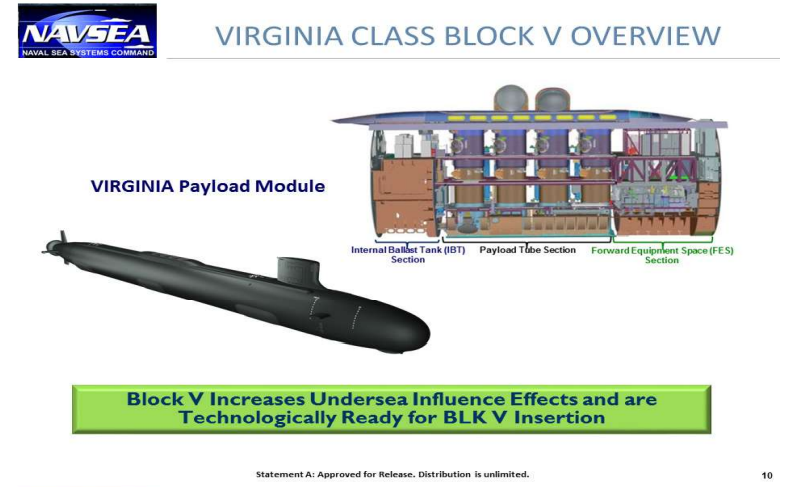
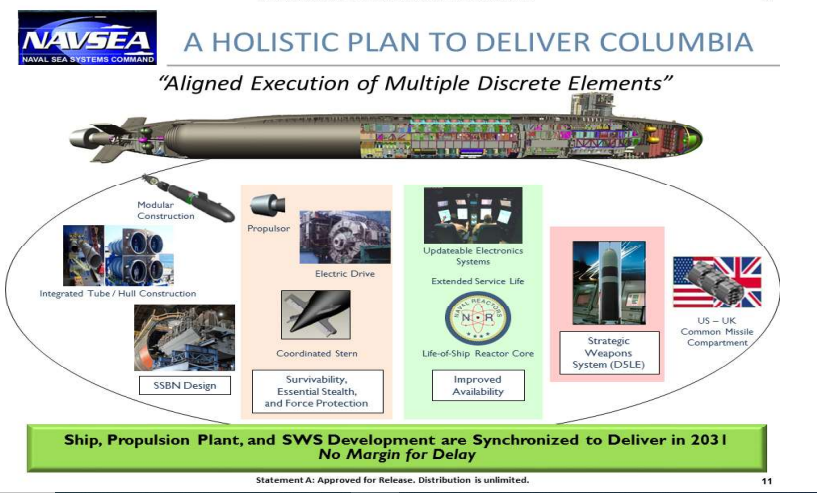
Columbia, of course, a lot of focus on this. This is the team that’s working Columbia. This is an impressive team. Obviously you’ve got NAVSEA, Naval Reactors, SEA 05, PEO Submarines, PMS-397, heavily engaged in this. We’ve got SSP engaged in this too with the strategic weapons system, with the missile tubes, a lot of amazing capabilities coming. This is well underway. This is a big part of SEA OS’s job, get ting the ship ready to go to sea at the end of 2031.
And then SSNS, I alluded to that on the TSEP slide earlier. One of the things we are looking at really hard in NAVSEA is set based design. Who out here has heard of set-based design? Maybe a quarter of you. Think of the way we design ships and submarines traditionally.
You basically come up with a low, medium and high mix of options. Because we did a lot of this work manually or even with computers, somewhat in stovepipes, you had to, very early on, settle on what the low-end capability would be, then the medium and the high. Then you would iterate on those until you came up with a solution that you thought could meet the requirements and also do it in an affordable way.
Today with the capabilities we have with computing power and the ability to actually run models in parallel with tools like Model Builder, we can be running a hydro model and weight and stability model, and maybe a fuel model. We can run all these models in parallel. With that capability we no longer have to down select to two or three options early. You can keep the design space open for a much longer period of time. You actually come up with thousands of iterations of possible solutions, really tens of thousands!
What you very quickly find is that there are knees in the curve that you can easily find where the cost breaks are. You can easily find where the speed break is, the range breaks are, and those really help you set the requirements properly as well as very tightly couple the model with a cost model to come up with a high-fidelity cost model upfront. Again, oftentimes you do this kind of low, medium, high mix and may have three pretty good models, but you’ re missing a lot of trade space in the middle.
So we’re doing a lot of work in this area on the surface side. It’s time to bring this to the submarine side, and I think my EB friends and HII friends are all totally in agreement here. SSN(X) is definitely the place to bring this on, if not before.
We talked about getting off board. This is another huge area that NAVSEA is working hard on. Captain John Rucker from of PMS-406
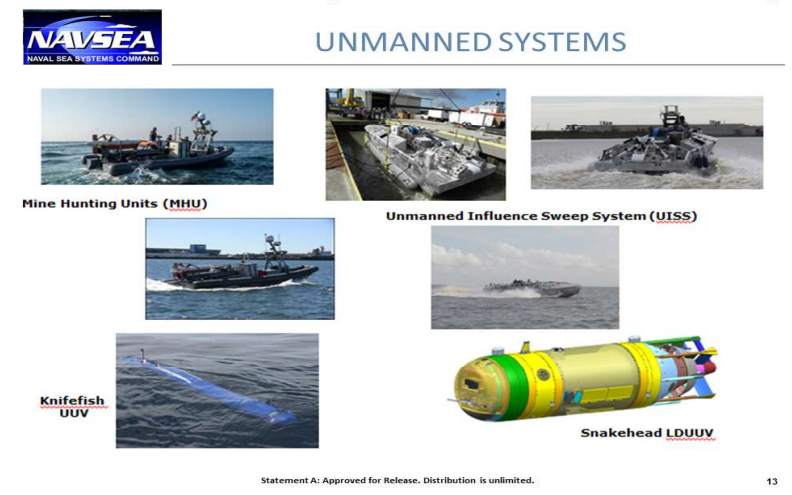
has now got all these systems: unmanned surface vessels as well as un manned underwater vehicles.
A lot of great work has been going on over the past several years if I go back to my N87 days when we started some of these programs back in the late 2009-2010 timeframe a lot of work has been going on in this area. We are now actually testing a lot of systems. We’re learning a great deal about their endurance, their autonomy, and we’re finding some things we need to focus on. Some of those areas are right here.
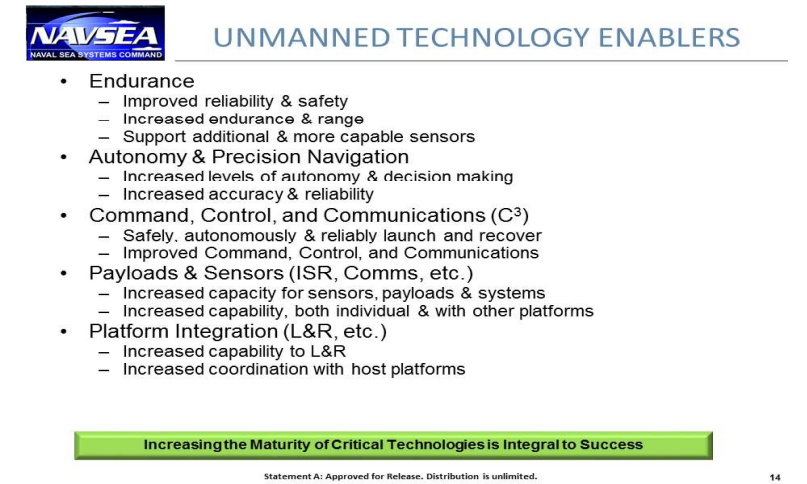
Endurance: it’s no surprise that batteries continue to be a concern for us after the ASDS fire back in 2008. We’ve done a lot of work in that area to try and mitigate those risks and finding ways to prevent fire propagation between cells, which is one of the biggest concerns we have. If you lose one cell and it propagates throughout the entire battery that can be a catastrophic loss of the vehicle and maybe the platform that carries it. So we’re working hard to find ways to prevent that propagation. We’re also looking at things like fuel cells.
Autonomy and precision navigation: If we’re going to disconnect from the host platform, whether it’s a submarine, a surface ship or even the pier, you’ve got to have a great deal of autonomy as well as navigation capability to get you where you’re intending to go as well as to get you back, if not to the location it’s launched from to some pre determined location where you can recover the vehicle.
Command and control and communications, how do you keep in touch with this vehicle when it’s off board? Is it going to go to periscope depth once in a while to ‘plug in’? Is it going to have a fiber connected to a host platform? Is it going to have some bottom node it talks to or plugs into? These are things we’ve got to work through.
Payloads and sensors: The vehicle is great but it’s really only a truck used to carry a payload, so we’re looking at innovations for the payloads on all of these vehicles. So there’s a lot of parallel work with sensors and different capabilities that can be integrated with these vehicles.
And there’s the interfaces to the host platform. So again, it might be an amphib, it might be a submarine, it might be a pier in Guam, but you’ve got to figure out how you’re going to work those interfaces. Whatever the launch and recovery vehicle is, you’ve got to find a way to get the vehicle off and on its way and then get it back on the host plat form. And yes, even in heavy sea states – that’s not a trivial evolution.
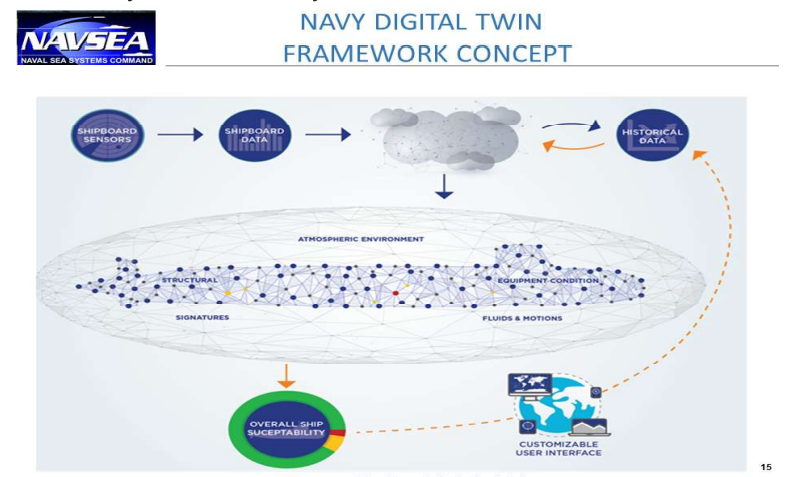
Earlier I talked about what I’ve got SEA OST and OSZ working on. One really exciting area is Big Data. Who has heard of a digital twin? You can’t swing a dead cat without hearing about it. GE, Siemens and many other big companies are there talking about this. And there are a lot of small companies as talking about it as well.
The concept is that you model a component, let’s say a gas turbine. So you model that gas turbine, using physics and science – you know PV=nRT, F=ma, etc. You model that component and you figure out how it’s supposed to work when everything goes perfectly. Then you instrument and ad sensors to the real component. You’re collecting pressure data, flow data, fuel data, altitude data for a jet airplane, and you then marry the real data from the sensors to the perfect data from the model.
So you’re running this model in the virtual world and you’re comparing it to the real component. Over time you look for divergence between the two – and if you see divergence you go start asking the questions of why. Is it because the altitude is not what we had predicted? Is it because there’s some problem with the fuel pump? Is it some 0-ring? Is it some component that is potentially failing?
Those are things you’re going to try to figure out. We think we can do this for a lot of components: diesels, turbines, pumps, valves, high pressure air compressors. The list probably goes on and on. NAVSEA has several pilot projects we are working now and we’re actually providing data from certain surface ship components.
So we’re starting with our destroyers and cruisers and we’re providing diesel data, gas turbine data and reduction gear data. We’re allowing teams to apply their analytics to the data to see if they can actually predict the things we know have happened. Because we are giving them historical data, we know the answer and we give this data to them and see if they can find something ahead of the event.
So far, it’s promising. We’re getting some interesting results. We’re going to do this for about another year until sometime next summer or fall, and then we’re going to converge on a solution. Then we’re going to go off and find ways to apply these analytics. Initially we’re going to do the destroyers, maybe LCS, and then we’re going to figure out, how does that apply to a submarine?
There’s huge promise here. If you talk to the airlines, you talk to companies like GE, they’ve shown us data on savings, fuel savings. They’ve found that they can actually help the airlines operate their planes more efficiently, selecting altitudes, selecting routes based on headwinds and other things, based on the way the components are operating, not just on the physics of flying, but how the actual component operates in those environments.
So this is actually, I think, pretty exciting stuff. When you think about the Big Data implications of this, I think this has huge potential savings. My goal is really providing operational availability back to the fleet. How do we operate ships or submarines or aircraft carriers, and all the components on those vessels more optimally to ensure we can operate those ships longer and keep them at sea as needed by their commanders? That’s what we want to get to.
So then when you do maintenance, you’re actually coming in with a work package which you generate based on the data coming from these different analytic tools to help us optimize those availabilities so when you come into port you optimize what you do in port. Instead of doing maintenance every six months because that’s what the average has been over the last 20 years for that component, we’re going to do it based on what that component needs based on the data we’re getting from that ex act component on that exact ship.
So it may not be six months, it might be 12 months for that one. It may be three months, but we’re going to find out. That’s the goal. So that’s where we’re trying to go as we push NAVSEA and the Navy into the digital future.
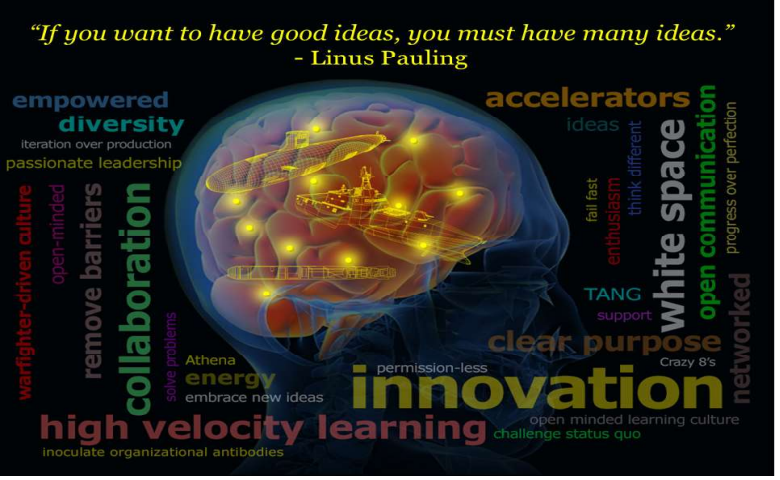
That’s what I had prepared. This is my get off the stage slide. I’d really like to entertain any questions you’ve got on what we’re doing or anything I’ve put out here today. Thank you.
(Applause).

